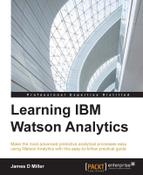In this chapter, we will explain how identifying use cases will help you better leverage the technology of IBM Watson Analytics to gain powerful insights through content analytics. This chapter will also cover how to ask the right questions of data and ensure that the correct context is used during analysis. Several real-life scenarios will be cited and explained.
This chapter is broken down like this:
- Defining a use case
- What to ask about your data
- Putting data in to context
- Working use case examples
First, we'll assume that you have at least a general understanding of what a use case is and perhaps only require the generally accepted definition of the term as a reminder:
"A use case is a list of action or event steps, typically defining the interactions between a role (known in the Unified Modeling Language as an actor) and a system, to achieve a goal" – Systems Modeling Language (SysMl).
Effectively, a use case is a true-to-life situation that occurs within your organization or field of interest. These common situations or scenarios (or collections of scenarios) are opportunities in which Content Analytics (IBM Watson Analytics) can be used to provide actionable results and insights.
Use case scenarios are normally user concentrated, provide easily understood narratives, promote quality, and facilitate validation:
- User concentration: A use case definition begins with the identification of an actor interacting with a process or system with an intended goal in mind.
- Understandable narratives: Use cases are generally written in a natural, textual form, yielding a legible requirement—not computer code—so it's understandable by everyone.
- Promotion of quality: The development of a use case can be accomplished using a standard template that consists of a basic flow and exception flows. This is a structured and beneficial way to get clear, stable, and high quality requirements systematically.
- Facilitation of validation: A use case facilitates straightforward derivation of functional test cases directly from the use cases providing a process for easy validation of assumptions or results.
By developing use case scenarios, you develop a deep understanding of your need or opportunity—detailed requirements for a new order processing system for an example, or maybe the insight you achieve from the process of creating a use case—based on your information (or data).
The actor in your use case scenario has an objective. Through (most likely) a series of interactive steps, it consumes information. It interprets and evaluates that information to make a decision and, hopefully, provide awareness that is not previously known (that is, an insight). Watson Analytics learns in the same manner.
It observes, interprets, and evaluates the data to help you make better and more informed decisions and presumably provide better or more reliable insights. The magic is that this learning process is all performed at a scale never imagined before!
Your established use case scenarios can translate directly into the where and how IBM Watson Content Analytics can be of help to you. This information will be the basic design for your Content Analytics solution.
